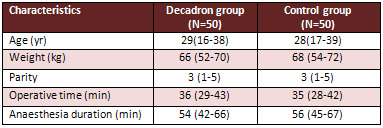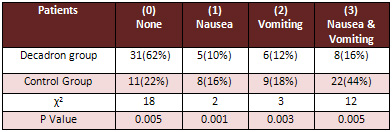| |
January
2015
- Volume 9, Issue 1
Decadron
therapy on prevention of post operative nausea and vomiting
following caesarean section

|
 ( (
|
Alen Alfanek (1)
Nadia Alkhasawneh (1)
Sami Magableh (2)
Luai Al-Daklalah (3)
(1) Msc pharm, Department
of Pharmacy, Royal Medical Services, Jordan
(2) Specialist, Department of pediatrics, Royal Medical
Services, Jordan
(3) Specialist, Department of Anaesthesia, Royal Medical
Services, Jordan
Correspondence:
Alen Alfanek
Msc pharm, Department
of Pharmacy,
Royal Medical Services, Jordan
Email: alenfanik@yahoo.com
|
 |
|
Abstract
Objective: To assess the value of short-term
decadron (Dexamethasone) therapy on prevention of post
operative nausea and vomiting following caesarean section.
Design and method: A randomized control study
was done between the 1st of March 2012 and the end of
April 2013 at King Hussein Medical Center. During this
period a total of 100 full term women scheduled for
elective caesarean section under spinal anaesthesia
were included in the study. 50 women were given 8 mg
decadron injection and another 50 women were considered
as control group. The total incidence of nausea and
vomiting was calculated.
Results: During the study period, 100 women enrolled.
There was no significant difference among both groups
with respect to age, weight, parity, duration of anaesthesia
and surgery. In the decadron group, nausea and vomiting
were absent in 62% of patients, while only nausea and
vomiting were absent in 22% of patients in the control
group. Also 16% had nausea and vomiting in the first
post operative period in the decadron group, while 44%
had nausea and vomiting in the first post operative
period in the control group.
Conclusion: Dexamethasone significantly decreased
the total incidence of nausea and vomiting in patients
who underwent caesarean section under spinal anesthesia
compared with the control group. Also dexamethasone
injection is simple to administer and provides a safe
and very effective antiemetic protection.
Key words: Dexamethasone, nausea and vomiting,
caesarean section.
|
Introduction
Nausea and vomiting are among the most unpleasant experiences
associated with cesarean section and one of the most common
reasons for poor patient satisfaction rating in the postoperative
period(1). Nausea and vomiting is seen in almost 50-80% of
the patients undergoing cesarean section (CS) under regional
anaesthesia when no prophylactic antiemetic is given(2). PONV
can cause more hospital stay and admissions following day
surgery, therefore increasing medical costs. Many different
factors like psychogenic factors, surgical procedure itself,
traction of the visceral peritoneum, uncorrected hypotension,
administration of opioid drugs and uterotonic agents can lead
to nausea and vomiting(3).
Dexamethasone is a corticosteroid with antiemetic and high
anti-inflammatory effects. Use of dexamethasone in combination
with the other drugs has been reported to increase the antiemetic
or analgesic efficacy, and minimal side effects have been
reported when it is used as a single agent(4). Recently various
studies have been conducted to evaluate the efficacy of steroids
in managing PONV(5). Optimum dose was found to be 10mg of
dexamethasone, and the same dose was found to be highly effective
when given immediately before induction rather than at the
end of anaesthesia(6).
Dexamethasone (Decadron) is a potent synthetic member of the
glucocorticoid class of steroid drugs that has anti-inflammatory
and immunosuppressant effects, while having minimal mineralocorticoid
effect. Dexamethasone has an established role in decreasing
postoperative nausea and vomiting (PONV)(7).
The purpose of this study is to assess the value of short-term
decadron therapy on prevention of post operative nausea and
vomiting following caesarean section under regional anaesthesia.
Patients and Methods
A randomized control study was conducted between the 1st of
March 2012 and the end of April 2013 at King Hussein Medical
Center. King Hussein Medical Center is one of the main referral
hospitals in Jordan. It serves a population of about one million,
and the maternity care unit receives about 700-800 deliveries
monthly. The study was approved by the ethics committee and
informed written consent from all participants was obtained.
During the study period, we enrolled
100 full term women weighing 55-80 kg, between the ages 16
to 40 years, scheduled for elective caesarean section under
spinal anaesthesia. 50 women were given 8 mg decadron injection
one hour prior to caesarean section and another 50 women were
considered as the control group. No premedication was given
in all patients and lactated Ringer's solution 500 ml was
given i.v before surgery.
The patients were evaluated for possible adverse effects such
as nausea and vomiting. Assessment for PONV was continued
every 4 hours until the first 24 hours. Nausea was defined
as a subjectively unpleasant sensation associated with awareness
of the urge to vomit; vomiting was the forceful expulsion
of gastric contents from the mouth. Nausea and vomiting were
evaluated on a 4-point ordinal scale (0=none, 1=nausea, 2=vomiting.3=nausea
and vomiting). The total incidence of nausea and vomiting
was calculated. Chi square and P value were calculated.
Patients excluded from the study were those with gastrointestinal
disease or administration of antiemetic medication in the
previous 24 hours, and patients who had obstetric complications
or evidence of fetal compromise.
Results
During the study period, 100 women were enrolled in the study.
There was no significant difference among both groups with
respect to age, weight, parity, duration of anaesthesia and
surgery as seen in Table 1.
Table 1: Patients' characteristics for two groups

Neonatal outcome was similar in the two groups and all the
neonates had Apgar scores > 8 at one and five minutes.
Table 2 compared between two groups regarding the incidence
of nausea and vomiting. In the decadron group, nausea and
vomiting were absent in 62%
of patients, 10% (5 patients) had nausea, 12% (6 patients)
had vomiting, while 16%(8 patients) had nausea and vomiting
in the first post operative period. In the control group,
only nausea and vomiting were absent in 22% of patients, 16%
(8 patients) had nausea, 18% (9 patients) had vomiting, while
44% (22 patients) had nausea and vomiting in the first post
operative period.
Table 2: Comparison of Nausea
and Vomiting incidence in the 2 groups

Discussion
Nausea and vomiting are common side effects in parturients
undergoing caesarean delivery performed under spinal anaesthesia
and can be very unpleasant to the patients. The reported incidence
of nausea and vomiting during caesarean performed under regional
anaesthesia varies from 50% to 80% when no prophylactic antiemetic
is given. Therefore, use of prophylactic antiemetics in parturients
undergoing caesarean delivery is recommended by some authors(8).
Nausea and vomiting during regional anesthesia for cesarean
section still remains a significant problem not only for the
patient, but also for the surgeon and the anesthesiologist
as well. The etiology of intraoperative nausea and vomiting
is complex; it may be attributed to surgical stimulation,
hypotension, vagal stimulation and uterotonic drugs. Patient
demographic data and anesthetic technique also can play a
role(9).
Dexamethasone is used for preventing and treating post operative
nausea and vomiting. The mechanism of action of dexamethasone
is not fully elucidated. There are 2 theories: prostaglandin
antagonism and release of endorphins. Dexamethasone was shown
in a systematic review to be better than placebo in preventing
postoperative vomiting (relative benefit 1.50; 95% CI 1.07
to 2.09; p < 0.01)(10).
The result of this study demonstrates that administration
of intramuscular decadron injection one hour prior to caesarean
section can reduce the incidence of nausea and vomiting among
patients under spinal anaesthesia. The mechanism for the antiemetic
effect of dexamethasone remains unknown. As Bisgaard et al(11)
concluded that preoperative dexamethasone (8 mg) reduced pain,
fatigue, nausea and vomiting, and duration of convalescence
in patients undergoing non complicated LC, when compared with
placebo, and is recommended for routine use. Also Cardoso
et al(12) in their study found that dexamethasone reduced
the cumulative incidence of nausea and vomiting after caesarean
section under spinal anaesthesia.
But Voigt et al(13) in their study recommended a prophylactic
medication with tropisetron 2 mg and metoclopramide 20 mg
for patients during caesarean section. These agents are safe,
reasonably priced, and highly efficient in preventing nausea
and vomiting. While Fujii(14) said that overall, these pharmacological
and non-pharmacological therapy reduces emetic episodes in
parturients undergoing regional anesthesia for cesarean delivery.
The clinician must weigh the benefits of using pharmacological
and non-pharmacological techniques for nausea, retching, and
vomiting in parturients undergoing cesarean delivery performed
under regional anesthesia.
Conclusion
Dexamethasone significantly decreased the total incidence
of nausea and vomiting in patients who underwent caesarean
section under spinal anesthesia compared with the control
group. Also dexamethasone injection is simple to administer
and provides safe and very effective antiemetic protection
over the whole 24- hour period. Further, studies are needed
to prove the safety of dexamethasone in parturients undergoing
caesarean section.
References
1. Karanicolas PJ, Smith SE, Kanbur B, et al: The impact of
prophylactic dexamethasone on nausea and vomiting after laparoscopic
cholecystectomy: A systematic review and meta-analysis. Ann
Surg 2008; 248:751- 62.
2. Harmon D, Ryan M, Kelly A, Bowen M. Acupressure and prevention
of nausea and vomiting during and after spinal anaesthesia
for caesarean section. British journal of anaesthesia. 2000;84:463-467.
3. Balki M, Carvalho JC. Intraoperative nausea and vomiting
during cesarean section under regional anesthesia. International
journal of obstetric anesthesia. 2005;14:230-241.
4. Parrington SJ, O'Donnell D, Chan VW, Brown-Shreves D, Subramanyam
R, Qu M, Brull R. Dexamethasone added to mepivacaine prolongs
the duration of analgesia after supraclavicular brachial plexus
blockade. Regional anesthesia and pain medicine. 2010;35:422-426.
5. Liu YH, Li MJ, Wang PC, et al. Use of dexamethasone for
preventing post operative nausea and vomiting after tympanomastoid
surgery. Laryngoscope 2001; 111:1271-1274.
6. Wang JJ, Ho ST, Tzeng JI, Tang CS. The effect of timing
of dexamethasone administration on its efficacy as a prophylactic
antiemetic for postoperative nausea and vomiting. AnesthAnalg
2000; 91:136-139.
7. De Oliveira GS Jr, Castro-Alves LJ, Ahmad S, Kendall MC,
et al. Dexamethasone to prevent postoperative nausea and vomiting:
an updated meta-analysis of randomized controlled trials.
8. Shahriari A, Khooshideh M, Heidari MH. Prevention of nausea
and vomiting in caesarean section under spinal anaesthesia
with midazolam or metoclopramide. J Pak Med Assoc. 2009 Nov;59(11):756-9.
9. Mohamed F, Firas D, Riadh B, Walid D, et al. Combined use
of metoclopramide and dexamethasone as a prophylactic antiemetic
in elective cesarean section under spinal anesthesia. Middle
East J Anesthesiol. 2012 Oct;21(6):829-34.
10. Wilhelm SM, Dehoorne-Smith ML, Kale-Pradhan PB. Prevention
of postoperative nausea and vomiting. The Annals of Pharmacotherapy.
2007; 41(1): 68-78.
11. Bisgaard T, Klarskov B, Kehlet H, Rosenberg J. Preoperative
dexamethasone improves surgical outcome after laparoscopic
cholecystectomy: a randomized double-blind placebo-controlled
trial. Ann Surg. 2003 Nov;238(5):651-60.
12. Cardoso MM, Leite AO, Santos EA, Gozzani JL, et al. Effect
of dexamethasone on prevention of postoperative nausea, vomiting
and pain after caesarean section: a randomized, placebo-controlled,
double-blind trial. Eur J Anaesthesiol. 2013 Mar;30(3):102-5.
13. Voigt M, Fröhlich CW, Hüttel C, Kranke P, et
al. Prophylaxis of intra- and postoperative nausea and vomiting
in patients during cesarean section in spinal anesthesia.
Med Sci Monit. 2013 Nov 14;19:993-1000.
14. Fujii Y. Prevention of emetic episodes during cesarean
delivery performed under regional anesthesia in parturients.
Curr Drug Saf. 2007 Jan; 2(1):25-32.
|
 |




